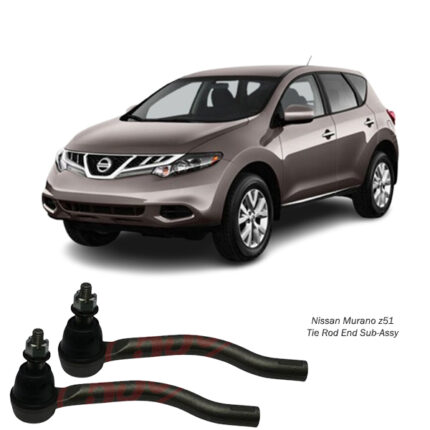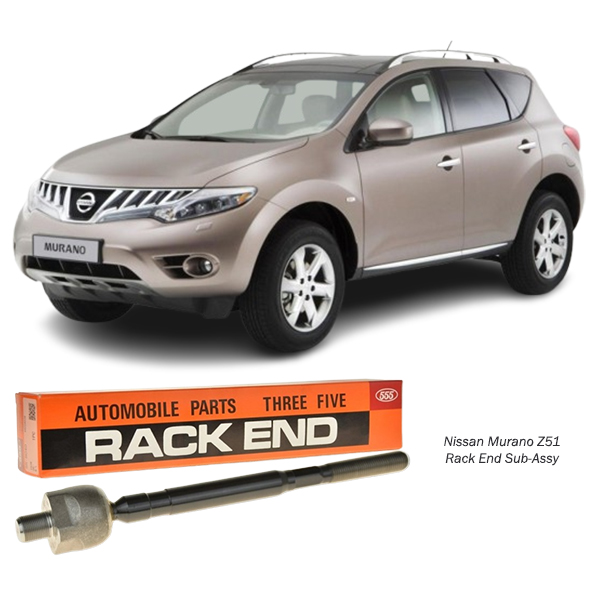-12%
Get Nissan Murano Z51 Rack End Sub Assy SRN230 in Kenya
The Rack End Sub Assembly (often referred to simply as the “rack end” or “tie rod end”) is a critical component of a vehicle’s steering system, specifically within rack-and-pinion steering setups. It functions as the link between the steering rack and the wheels, allowing for effective turning and steering control. This part plays an essential role in the precise and responsive handling of a vehicle and directly impacts road safety and driving comfort. The rack end sub assembly is also responsible for absorbing road shock, which is vital for maintaining a smooth ride and protecting other components within the steering system.
In this guide, we’ll explore the structure, function, and types of rack end sub assemblies, along with tips on maintenance, signs of wear, and the importance of timely replacement.
1. Understanding Rack-and-Pinion Steering Systems
Rack-and-pinion steering systems are widely used in modern vehicles due to their simplicity, efficiency, and responsiveness. They consist of a steering rack (a linear gear connected to the wheels) and a pinion gear (attached to the steering column). When the driver turns the steering wheel, the pinion rotates and moves the rack side-to-side, steering the wheels left or right.
The rack end sub assembly connects the outer end of the steering rack to the steering knuckles at each wheel. It ensures that the rotational force generated by the steering wheel is accurately transmitted to the wheels, allowing the vehicle to turn smoothly and precisely.
2. Key Components of the Rack End Sub Assembly
The rack end sub assembly consists of several parts that work in unison to transmit force and provide flexibility and stability to the steering system. These include:
- Rack End (Inner Tie Rod): This component connects directly to the steering rack and absorbs much of the movement and force from the rack, transmitting it to the outer tie rod.
- Outer Tie Rod: Connected to the inner tie rod at one end and to the steering knuckle at the other, the outer tie rod transfers force directly to the wheel.
- Ball Joint: Located at the connection between the outer tie rod and the steering knuckle, this flexible joint allows the wheels to pivot as they turn.
- Protective Boot: The rack end is covered by a protective boot or rubber cover that prevents dirt, debris, and moisture from reaching the inner components, preserving their integrity and lifespan.
These components are collectively referred to as the tie rod end assembly or rack end sub assembly. Together, they enable efficient, accurate movement within the steering system, ensuring the wheels turn in response to driver input.
3. Functionality of the Rack End Sub Assembly
The primary function of the rack end sub assembly is to allow the wheels to turn according to the driver’s steering input while absorbing and mitigating road impacts. Here’s a breakdown of how it achieves this:
a. Steering Control
As the steering wheel turns, the rack end sub assembly translates the rotational movement of the steering wheel into a linear movement. This movement pushes or pulls the steering knuckles, causing the wheels to turn left or right. The accurate transfer of this motion is essential for precise steering control and vehicle handling.
b. Absorption of Road Shock
The rack end sub assembly is built to absorb road shock and vibrations that would otherwise transfer through the steering wheel to the driver. By reducing road shock, it enhances driving comfort and protects the internal steering components from excessive wear.
c. Maintaining Alignment
The rack end plays a crucial role in maintaining proper alignment and stability of the front wheels. Poor alignment can lead to uneven tire wear, poor handling, and increased fuel consumption. The rack end assembly, along with the suspension system, keeps the wheels aligned for better control and efficiency.
4. Types of Rack End Sub Assemblies
There are different types of rack end assemblies, typically categorized based on the type of steering and suspension systems in use. Here are the main types:
a. Standard Rack End
This is the most common type, used in rack-and-pinion steering systems. Standard rack ends are suitable for vehicles designed for smooth, everyday driving and are usually made from durable metals such as steel or aluminum.
b. Heavy-Duty Rack End
Designed for off-road and heavy-duty vehicles, heavy-duty rack ends are built to withstand more significant road shocks and rough terrain. These types are generally larger, more robust, and often reinforced with stronger materials to increase their lifespan and resilience.
c. Adjustable Rack End
Some rack ends come with adjustability features, allowing for fine-tuning of alignment settings. These are ideal for vehicles where precise steering and handling are required, such as performance or racing vehicles. Adjustable rack ends can be more complex and may require periodic adjustments to maintain optimal alignment.
5. Materials and Design Considerations
Rack end assemblies are constructed from high-quality metals like steel or aluminum to provide durability and resistance to wear. Key design considerations include:
- Strength and Durability: Rack ends need to withstand substantial force and vibration without failing.
- Flexibility and Movement: The ball joint and other flexible components within the rack end must move freely to allow smooth turning.
- Corrosion Resistance: Given their exposure to road debris and moisture, rack ends often have coatings or treatments to prevent rust and corrosion.
The design and materials of rack end assemblies are chosen to ensure maximum performance, reliability, and longevity.
6. Signs of Wear and Failure in Rack End Sub Assemblies
Rack end assemblies are subject to continuous stress and movement, which can lead to wear over time. Here are some common signs that indicate potential issues with the rack end sub assembly:
a. Steering Play or Looseness
One of the most noticeable signs of a worn rack end is excessive play or looseness in the steering. The steering wheel may feel less responsive, making it challenging to maintain control.
b. Uneven or Rapid Tire Wear
If the rack end assembly is worn, it can cause misalignment of the wheels, leading to uneven or accelerated tire wear. This misalignment affects vehicle handling and compromises safety.
c. Clunking or Knocking Sounds
A worn or damaged rack end can produce clunking or knocking sounds, particularly when driving over rough terrain or making turns. This noise is typically caused by a loose or failing ball joint within the assembly.
d. Vibration in the Steering Wheel
Excessive vibration felt in the steering wheel may indicate a worn rack end or other steering component. This issue can compromise handling and driver comfort.
e. Difficulty in Steering
If the rack end assembly is damaged or worn, steering can become challenging, especially when turning at low speeds or during parking maneuvers. This indicates the assembly may need immediate attention or replacement.
7. Maintenance Tips for Rack End Sub Assemblies
Proper maintenance can extend the life of the rack end assembly and help avoid costly repairs. Here are some maintenance tips:
a. Regular Inspections
Routine inspection of the steering system, including the rack end assembly, is essential. Check for any signs of wear, cracks, or damage. An inspection can identify issues before they become severe, improving vehicle safety.
b. Wheel Alignment Checks
Maintaining proper wheel alignment reduces stress on the rack end assembly and other steering components. Misalignment can accelerate wear and cause steering problems, so regular alignment checks are beneficial.
c. Lubrication
Some rack end assemblies come with lubricated ball joints that require periodic greasing. Ensure the joints are lubricated to reduce friction and wear, enhancing smooth movement.
d. Replacing Damaged Protective Boots
The rubber boot on the rack end assembly protects internal components from dirt, moisture, and road debris. If the boot is damaged, replace it promptly to prevent contamination and further wear.
8. Replacement of the Rack End Sub Assembly
Replacing a worn rack end sub assembly is essential for maintaining safe and precise vehicle handling. The process typically involves removing the wheel, loosening the old rack end, and installing a new one with the correct alignment. It’s best to have a professional mechanic handle replacement to ensure the vehicle’s alignment and steering functionality are maintained.
Conclusion
The Rack End Sub Assembly is a critical part of the vehicle’s steering system, enabling precise control, handling, and alignment. Regular inspection and timely replacement of worn components are essential for safety, driving comfort, and performance. Investing in quality parts, maintaining proper alignment, and ensuring cleanliness and lubrication will help keep the rack end assembly functioning optimally for a smoother, more reliable driving experience.
Follow us on Facebook for more parts.





